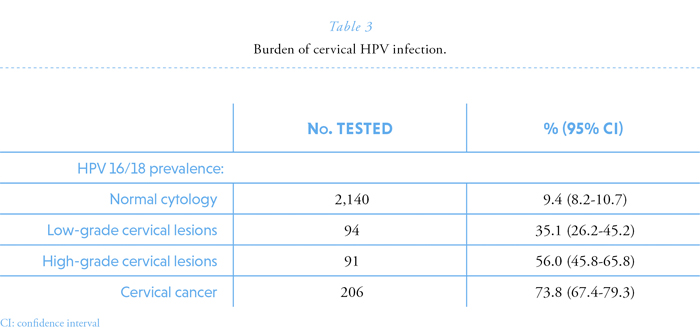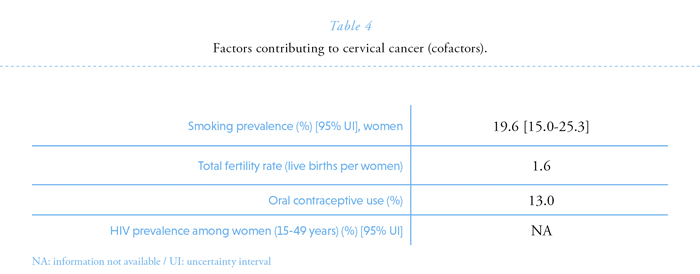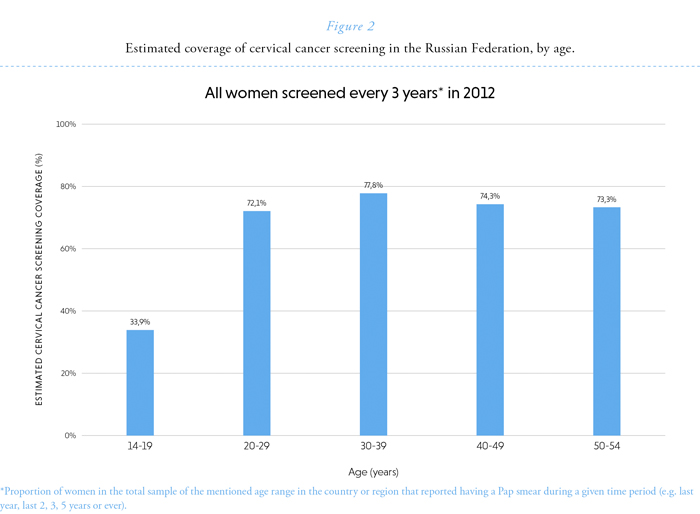Международный центр по ВПЧ опубликовал данные по России
S. Rogovskaya, G. Albero, L. Bruni (March 2022). Russia. Human Papillomavirus and Related Cancers, Fact Sheet (last updated: October 2021). www.HPVWorld.com, 190
Comment:
Cervical cancer (CC) and genital warts (GWs) are the most common and well-known manifestations of human papillomavirus infection (HPV). Both continue to be a significant public health problem in the Russian Federation (RF). There is limited data about other HPV-related diseases in RF. According to data published by the main oncologist in RF, in 2020 CC prevalence rate is 128.1 per 100,000 women, and incidence rate is 13.67 per 100,000 women (15.8 in 2018).1,4 Last data could have been biased by Covid-19 pandemic. Unfortunately, 36.6% of primary cervical cancer was diagnosed in III-IV stage of disease.1
GWs incidence rate is 22.8 per 100,000 persons aged 18 years or older, the highest rate being in the age group of 18-29 years.2,3 However, GWs statistical data is less than real figures due to underreporting.
HPV prevalence data in cervical cancer cases in all regions of RF confirms the high contribution of HPV 16 and 18 types in 70-72% in the cancer tissue. HPV 6 and 11 are the most common HPV types among patients with GWs.2
An opportunistic cervical cancer screening service is available country-wide, and the percentage of screening-revealed cancer cases increased from 28.2% in 2009 to 41.1 % in 2019. The screening coverage of the population is however low.2
Clinical recommendations (CR) for CC prevention were developed and approved by non-commercial medical organizations and the Ministry of Health of RF (MoH) in 2021. According to CR for Cervical Cancer Screening and order 11.30 (2021) by MOH, CC screening is indicated in women between 21 and 69 years old with a 3-year interval: only cytology in the age group of 21-29 years, and cytology and HPV testing in the age group of 30-69 years.
Since 2006 there have been many pilot programs on HPV Immunization in regions of the RF, mostly targeting only girls aged 9 to 14 years, and including boys in a few of them. HPV vaccination is not yet included in the national immunization calendar and generally, vaccination coverage is low. The resistance of the population to accept HPV vaccination is high.
Implementation and functioning of the cervical cancer screening programs, including accessible and effective treatment of precancerous lesions, is generally supported by the public health system. Covid-19 pandemic situation has damaged the HPV prevention system.
References
1. Kaprina AD et al. Status of the oncological service for the population of Russia in 2020. Ministry of Health, Russian Federation, 2021. Available from: https://oncology-association.ru/wp-content/uploads/2021/10/pomoshh-2020-el.-versiya.pdf
2. Brico N et al. Clinical and epidemiological features of papillomavirus infection manifestations on the example of cervical cancer and genital warts. Bulletin of the Russian Academy of Medical Sciences, 2020; 75 (1):77-82. Available from: https://www.elibrary.ru/item.asp?id=42619908
3. Anogenital warts: clinical recommendations. Ministry of Health, Russian Federation, 2021. Available from: https://legalacts.ru/doc/klinicheskie-rekomendatsii-anogenitalnye-venericheskie-borodavki-utv-minzdravom-rossii/
4. Zaridze DG, Maksimovich DM, Stilidi IS. Cervical cancer and other HPV-associated tumors in Russia. J Oncology Questions, 2020; 66 (4): 325-335. Available from: http://www.pror.ru/storage/app/media/uploaded-files/sheyki-matki.pdf
The Catalan Institute of Oncology (ICO) in Barcelona, Spain and the International Agency for Research on Cancer (IARC) in Lyon, France jointly lead the HPV Information Centre, a web-based resource that compiles, processes and disseminates published information on HPV infection and HPV-related diseases for all countries of the world.
Country-specific Fact Sheets are standardized summaries of HPV-related disease burden and associated risk factors, prevention strategies, screening activities, and immunization programs for each of the 194 WHO member states. Fact Sheets include concise, self-explanatory graphs and tables to offer a quick overview of the situation in the designated population. The system allows queries to generate statistics for individual countries, groups of countries, geographical regions or worldwide summaries.
More elaborated supplementary tables and comments can also be found in country-specific, regional and worldwide Full Reports from the original database (www.hpvcentre.net). The HPV Information Centre publishes internationally recognized review monographs and targeted scientific publications to address relevant questions in the path to the cervical cancer elimination campaign. The HPV Information Centre is an open access, publicly funded resource to support the work of the scientific HPV community worldwide.
Russia: key data on HPV and HPV-related cancers
mon
The Russian Federation has a population of 65.4 millions women aged 15 years and older who are at risk of developing cervical cancer. Current estimates indicate that every year 15308 women are diagnosed with cervical cancer and 7550 die from the disease. Cervical cancer ranks as the 4th most frequent cancer among women in the Russian Federation and the 2nd most frequent cancer among women between 15 and 44 years of age. About 9.4% of women in the general population are estimated to harbor cervical HPV-16/18 infection at a given time, and 73.8% of invasive cervical cancers are attributed to HPVs 16 or 18.
References
1. Bruni L, Albero G, Serrano B et al. ICO/IARC Information Centre on HPV and Cancer (HPV Information Centre). Human Papillomavirus and Related Diseases in Russia. Summary Report 22 October 2022. Available from: https://hpvcentre.net/statistics/reports/RUS_FS.pdf?t=1646591300998
OTHER HPV INFORMATION CENTRE FACT SHEETS PUBLISHED IN HPW
Fact Sheet: Argentina
Fact Sheet: Italy
Fact Sheet: Japan
Fact Sheet: Mexico
Fact Sheet: Portugal
Fact Sheet: Republic of Korea
Fact Sheet: Spain
Fact Sheet: Brazil
Fact Sheet: Colombia
Fact Sheet: USA











